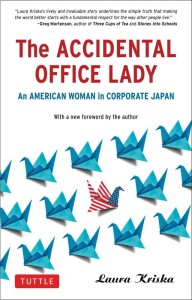JQ Magazine: Book Review – ‘The Accidental Office Lady: An American Woman in Corporate Japan’

“If you are going to Japan soon, live there now, or have lived there already, this book is a survivor’s guide and tool for reflection and growth. It can help the reader better understand what to do, and what not to do.” (Tuttle)
By Lana Kitcher (Yamanashi-ken, 2010-12) for JQ magazine. Lana is the business development associate for Bridges to Japan and enjoys working as a freelance writer for a number of online publications. To read more about Lana’s adventures in Japan, visit her blog at Kitcher’s Café.
Laura Kriska’s experience as recounted in The Accidental Office Lady parallels in many ways what we as JET participants go through when we temporarily leave our lives and routines at home to pursue the “exotic” and uncertain terrain of a new culture.
Based on Kriska’s background and education, she was offered a two-year position at Honda Motor Company headquarters in Tokyo, being the first American woman to do so. She arrived in Japan equipped with her new business attire and a mind full of expectations and dreams about how the next two years of her life in Tokyo would unfold. She was soon instructed to join the secretariat—coordinating schedules and serving tea to managers in her new, polyester uniform.
Through the course of the book we get to see Kriska transform from a newly minted grad into a successful member of Japanese society. She starts out frustrated by her new environment and deeply disappointed that her job is not all that she hoped it would be. As the book progresses, you start to see that she is losing her childish tendencies to fight back, and eloquently navigating the culture with words and mannerisms instead of outbursts and small rebellions. She takes on more responsibility and in the end is able to create lasting change at Honda with a new employee manual in English and the elimination of the mandatory uniform rule.
As JETs, or for me at least, working in Japan was a completely different experience to traveling or studying there. Every group I represented (American, New Yorker, female, university alumni, JET Program participant, foreigner in Japan, employee at Fuefuki Board of Education, and the list goes on…) was in danger because now the citizens and coworkers were judging everyone in those groups based on their interactions with me, in and out of the workplace.
Although Kriska’s book was first published in 1997—and republished in 2011 including a new foreword by the author—the stories and struggles that Kriska experienced are the same for many working in Japan today. As I read, I could relate to her feelings and the interactions that she had with her Japanese colleagues. Kriska’s account of Japan will at brief moments seem a little dated, but in general, eerily familiar.
Several reviewers on Amazon comment on Kriska’s “complaining” tone; however, this is an intentional and necessary stylistic choice of the author. She vividly recounts her observations and feelings truthfully every step along the way. Kriska allows us to see into her thoughts and actions, which better demonstrates the way that Japan was able to change her and allow her to grow throughout the course of the two years. Not only is The Accidental Office Lady about the first American woman to work at Honda in Japan, but it is also the story of a young girl growing up, learning what it means to become an adult. The account is relevant not only for people who want to live in Japan or do business with the Japanese, but also for anyone who is going to come in contact with people of other cultures and values, which in today’s world is nearly inevitable.
If you are going to Japan soon, live there now, or have lived there already, this book is a survivor’s guide and tool for reflection and growth. It can help the reader better understand what to do, and what not to do. She teaches us that having certain feelings about our cultural interactions is normal, but that learning, challenging ourselves, and making steps toward change are imperative to the growth and understanding process. The most important message that Kriska was able to learn and hopes to convey to her audience is that cultural mistakes are likely, and even almost impossible to avoid. It does not matter that we make mistakes, but that we try to understand and to adapt. As she states in the new introduction, “The starting point of these relationships, whether they are between individual tourists or government officials, must be respect and a wish to understand the many cultural factors that exist between different countries in the world.”
For more JQ magazine book reviews, click here.


Comments are closed.